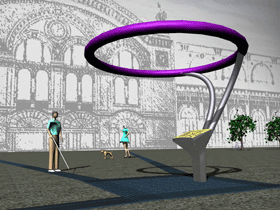
Project sketch of a blind guidance system/ ideal train stations/ Deutsche Bahn AG
Aim of the project:
Increase of the independence and the mobility of blind and visually impaired travelers
Definition of the target group
As a result of numerous discussions with concern it arose that the idea of the independence of the target group in all scenarios is not possible and also does not appear desirable.
The expenditure, which is to be carried for the target group for relative independence in everyday and working life, is very high and constant requires training. The success fluctuates because the attention-span often varies from person to person because of individual differences and situations.
Example:
An older blind person, which prefers only to stay in his/her well-known environment, (Neighborhood, shop on the corner) will not challenge him/herself to work through an elegant guidance system on a family visit, but is helped preferably by a person. (Travel advance notification, Mobility hotline)
This applies generally to persons from this group, which undertake single journeys, contrary to occupational commuters about, who have the chance to make themselves more familiar with the surrounding conditions.
Result:
As a target group, strictly speaking blind and visually impaired persons, those whose travel repeats more frequently have been chosen. Here is a substantial need for optimization and the chance for new customer service.
Action scenarios
Here are the demands of the target group which concern simplicity and comprehensibility. It is not regarded as useful to have the access to all theoretically conceivable degrees of freedom, but otherwise the core scenarios more stress-free and more surely to master.
These are:
- Navigation of taxi, streetcar/bus, between the train platform and train and final destination
- Navigation of train-car to the exit - > taxi, streetcar/bus
- Navigation of train-car to train-car or S and/or underground (train transfers)
- Navigation from the starting points mentioned to travel center
(Service POINT), toilets, restaurants, to shops or vice versa.
Conversion
Requirements from economical view
There is, at the present time, insufficient data related to the traveler traffic volume of mobility-reduced persons, and appears at this time that the economical value of an analysis is not possible.
It can be however noted that the target group is relatively small as compared to the total number of travellers.
- The system must be economical to produce.
- The system must be economical to maintain.
- The system should be simply designed and
expandable, as to grow as the requirements demand.
- The system must adhere to the total concept of service and
image improvements in (functionality/aesthetics <-> Corporate Identity)
(Use of materials, whose use is already planned in another place.
etc.).
Requirements of the users
In the transportation committees of the blind and visually impaired, the employment of electronic information requirement systems have been, since the 1980s, the center of discussion.
For this there were also model tests (BILOS 1990/Hamburg), GRP-System, ORTI.
Alongside the incontestable advantages, however, two general disadvantages were systematically formulated:
- The system needs special electronic equipment (procurement of batteries, loss, repair, handling)
- Since the information comes to the person through the ears, other noises from ther surrounding environment can cover important current acoustic information. (e.g. approaching a car or a streetcar)
- A further disadvantage is partially connected to thesubstantial costs is the necessity for the liability of the installation.
Result:
The present discussion concludes that a guidance system would have good chances to be accepted accordingly, if acoustic and tactile guideline assistance succeeded to come together in such a way that it:
- is simple and straightforward
- makes the continuation in the mobility training of learned orientation strategies
possible
- carries out the integration and reinforcement of already existing “more natural”
orientation points
- causes no dependence on special electronics
- is within the range of the acoustics alongside the functional aspects (content, conciseness,
Information depth etc. of the language announcements) and the aesthetic preferences
considering (sound, kind of the noises, sound of the voice)
Implementation
The following suggestions are understood as complementary measures of tactile walking indicators (Groove plates, carpets, attention fields), sign-posting of the stairs to and from the platform in Braille, etc.
A
Installation of several acoustic jumping wells in combination with relief maps, which are set up at important intersections. These can be designed individually by specific artists from the region
General area acoustic measures for reinforcement of “more natural” orientation points.
B A+
action keys integrated into the map that suppliy descriptions of location by announced texts.
Stereo signal chains out over the persons to appropriate pairs of loudspeakers showing the relative direction from the location to the places represented by the keys.
C B+
separate array of action keys for a text inquiry, operating instructions and different information levels.



